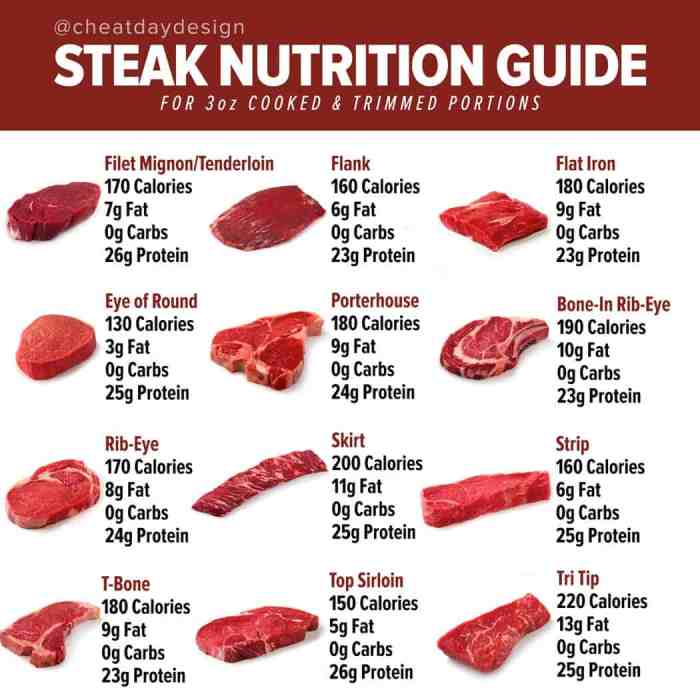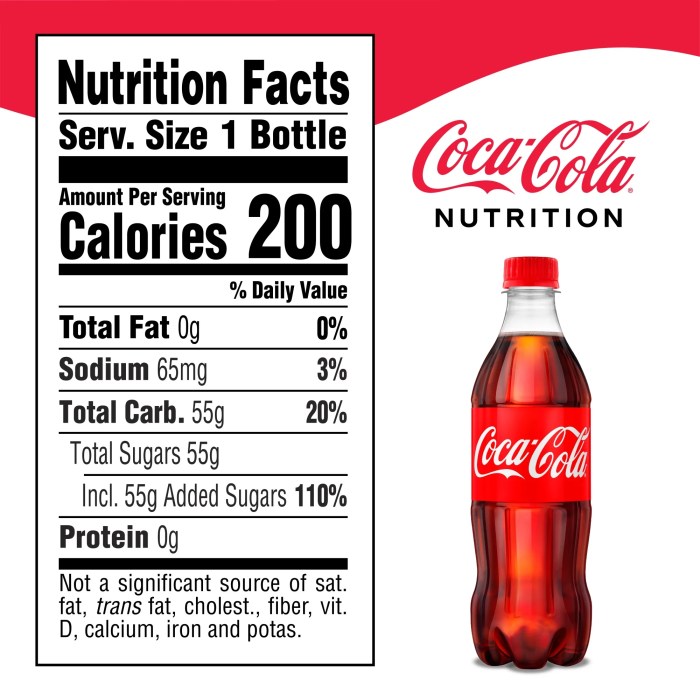Nutritional Composition of Beef Steak

Beef steak nutrition facts – Beef steak, a culinary staple across the globe, offers a rich source of various nutrients. Understanding its nutritional profile is crucial for making informed dietary choices, considering factors like cut and preparation method significantly impact the final nutritional content. This section provides a detailed breakdown of the macronutrients and micronutrients found in a typical 3-ounce serving of beef steak.
Macronutrient Composition of Different Beef Steaks
The macronutrient content of beef steak varies considerably depending on the cut. Leaner cuts, such as sirloin, naturally contain less fat compared to richer cuts like ribeye. Carbohydrates are negligible in beef steak. The primary macronutrients are protein and fat.
| Cut | Protein (grams) | Fat (grams) | Carbohydrates (grams) |
|---|---|---|---|
| Sirloin | 22-25 | 5-8 | 0 |
| Ribeye | 20-23 | 12-18 | 0 |
| Filet Mignon | 23-26 | 7-10 | 0 |
*Note: These values are approximate and can vary based on the specific animal, marbling, and trimming.*
Micronutrient Content of Beef Steak
Beyond macronutrients, beef steak is a good source of several essential micronutrients. These include various B vitamins crucial for energy metabolism, iron vital for red blood cell production, zinc important for immune function, and selenium, an antioxidant mineral. The cooking method can influence the micronutrient retention; for instance, grilling can lead to some nutrient loss compared to pan-searing or broiling.
| Nutrient | Sirloin (3 oz) | Ribeye (3 oz) | Filet Mignon (3 oz) |
|---|---|---|---|
| Iron (mg) | 3-4 | 2-3 | 2-3 |
| Zinc (mg) | 5-6 | 4-5 | 4-5 |
| Selenium (mcg) | 20-25 | 18-22 | 15-20 |
| Vitamin B12 (mcg) | 3-4 | 2-3 | 2-3 |
*Note: These values are approximate and can vary based on the specific animal, marbling, and preparation method.* The values represent a range to account for natural variations. For precise nutritional information, consult a nutrition label specific to the product.
Beef Steak and Specific Dietary Needs
Beef steak, a culinary staple enjoyed worldwide, presents a unique nutritional profile that requires careful consideration for individuals with specific dietary needs or health conditions. Understanding how to select and prepare beef steak appropriately can ensure it remains a part of a healthy and balanced diet, even with restrictions. This section will explore the suitability of beef steak for various dietary requirements and highlight potential interactions with medications or health conditions.
Beef Steak and Low-Sodium Diets
Individuals on low-sodium diets need to carefully manage their intake of sodium, often found in processed meats and heavily seasoned dishes. Choosing lean cuts of beef steak and preparing them with minimal added salt is crucial. Opting for grilling, broiling, or baking instead of frying helps reduce sodium content further. Many commercially available steak rubs and marinades are high in sodium, so using fresh herbs and spices is recommended.
Always check nutrition labels for sodium content if using pre-packaged seasonings. Relying on natural flavors like garlic, pepper, and lemon juice can enhance the taste without adding excessive sodium.
Beef Steak and Low-Fat Diets
For individuals following low-fat diets, selecting lean cuts of beef steak is paramount. Trimming visible fat before cooking significantly reduces the overall fat content. Lean cuts such as sirloin, tenderloin, and eye of round are preferable to fattier options like ribeye or short rib. Cooking methods that minimize fat addition, such as grilling, broiling, or baking, are also beneficial.
Beef steak, a rich source of protein and iron, offers a substantial nutritional profile. However, for a balanced diet, consider incorporating fruits and vegetables, such as the vitamins found in orange juice nutrition facts , which provide a contrasting nutritional boost. Ultimately, a varied diet including both beef steak and citrus fruits contributes to overall well-being.
Avoiding butter or excessive oil during cooking further contributes to a lower-fat meal. Portion control remains essential for managing overall fat intake.
Choosing and Preparing Beef Steak for Specific Dietary Needs, Beef steak nutrition facts
| Dietary Need | Recommended Cuts | Cooking Methods | Preparation Tips |
|---|---|---|---|
| Low-Sodium | Sirloin, Tenderloin, Eye of Round | Grilling, Broiling, Baking | Use fresh herbs and spices; avoid pre-packaged seasonings |
| Low-Fat | Sirloin, Tenderloin, Eye of Round | Grilling, Broiling, Baking | Trim visible fat before cooking; avoid added oils or butter |
| Low-Cholesterol | Lean cuts, smaller portions | Grilling, Broiling | Limit saturated fat intake; consider plant-based protein alternatives occasionally |
| High-Protein | Any cut (adjust portion size) | Any method | Pair with vegetables for balanced nutrition |
Beef Steak and Medication/Health Condition Interactions
Certain medications or health conditions may influence the suitability of beef steak consumption. For example, individuals with gout may need to limit purine intake, and beef contains purines. Those with kidney disease might need to restrict protein intake, requiring careful portion control of beef steak. Always consult with a healthcare professional or registered dietitian to determine the appropriate amount and frequency of beef steak consumption based on individual health circumstances and medication regimens.
They can provide personalized guidance considering specific health needs and potential interactions.
Visual Representation of Beef Steak Nutrition

Understanding the nutritional content of beef steak is greatly enhanced by visualizing its composition. A picture, in this case a detailed description, can effectively convey the relationship between the steak’s appearance and its nutritional profile. This allows for a more intuitive grasp of the macronutrient balance and the impact of factors like marbling on overall nutritional value.A perfectly cooked beef steak, ideally a ribeye, presents a captivating visual representation of its nutritional composition.
Imagine a medium-rare steak, its surface a deep mahogany brown, hinting at the Maillard reaction that contributes to its flavor and texture. The interior showcases a rich, reddish-pink hue, indicating the retention of moisture and juiciness. Notice the delicate network of white marbling throughout the muscle fibers; these intramuscular fat deposits contribute significantly to the steak’s tenderness, flavor, and overall caloric density.
The marbling is not uniformly distributed; some areas may show more fat than others, impacting the overall fat content per serving. A leaner cut will have less visible marbling, resulting in a lower fat and calorie count. The glistening surface reflects the natural juices, illustrating the high moisture content and protein density inherent in this food. The contrast between the browned exterior and the rosy interior is a visual indicator of the cooking process and its impact on the steak’s texture and nutritional value.
Macronutrient Proportions in a Beef Steak Serving
A simple visual representation of the macronutrient proportions in a typical 3-ounce serving of beef steak can be depicted as a pie chart. Imagine a circle divided into three segments. The largest segment, perhaps representing 60-70% of the circle, would be dedicated to protein, reflecting the high protein content of beef. A smaller segment, approximately 20-30%, would illustrate the fat content, the size of this segment varying depending on the cut and marbling.
The remaining, smallest segment (5-10%) would represent carbohydrates, which are relatively low in beef steak. This pie chart provides a quick and easy way to understand the relative contribution of each macronutrient to the overall nutritional value of a serving. For instance, a leaner cut will have a smaller fat segment compared to a more marbled cut. This simple visual aid effectively communicates the predominant role of protein in beef steak, along with the contribution of fat and the minimal carbohydrate content.
Frequently Asked Questions: Beef Steak Nutrition Facts
Can I eat beef steak every day?
While beef steak provides essential nutrients, daily consumption might lead to excessive saturated fat intake. A balanced approach, incorporating various protein sources and vegetables, is recommended.
Is beef steak good for weight loss?
Lean cuts of beef steak, consumed in moderation as part of a calorie-controlled diet, can be included in a weight-loss plan. Focus on portion sizes and choose lean cuts to minimize fat intake.
What are the best cooking methods for preserving beef steak nutrients?
Grilling, broiling, and pan-frying are common methods. Minimizing cooking time and avoiding excessive charring helps retain nutrients. Baking or slow cooking can also be healthy options.
Is beef steak suitable for people with high blood pressure?
Individuals with high blood pressure should choose lean cuts and limit portion sizes due to the sodium content. Consult a doctor or registered dietitian for personalized advice.








